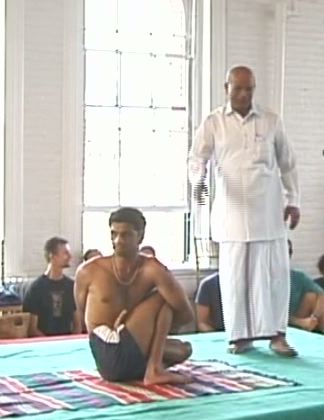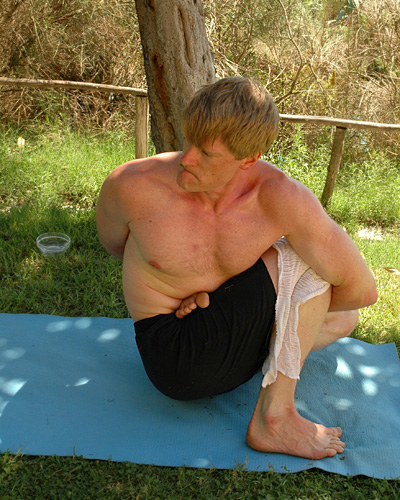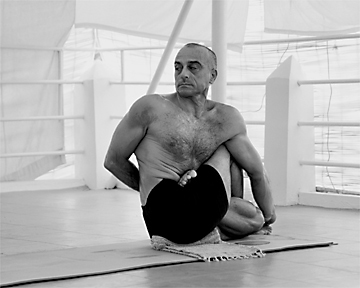alan little’s weblog
sometimes details do matter
11th January 2006 permanent link
Sometimes, however, details do matter.
In one of the yoga DVDs I borrowed from my teacher, Pattabhi Jois is talking Sharath through a demonstration. They get to Marichyasana D. Most people find Marichyasana D the hardest thing in the ashtanga primary series. I struggled with it for years, and still don’t find it easy. So Guruji clearly thinks it is worth pointing out an important detail about how Sharath is doing it:
Your hips and feet one line you take, easy is coming. Your feet is coming touching here [points to knee] trying you – no. Not coming that asana. This method!
In other words (English isn't Pattabhi Jois’s first language, or even his second or third), the foot that is on the floor should be tucked back towards the buttock. Like Sharath in this dodgy DVD screen grab:

Whereas I’ve always done it with the foot that is one the floor quite far forward, trying to bring that foot and the knee of the lotus leg close together. Here I am a couple of years ago, with the foot way forward although sadly not very far in towards the knee:

Sharath is of course thinner, stronger and more flexible than I am. But his grandfather is right, as he usually is about matters yogic: when I try with the foot further back, it’s an order of magnitude easier for me too.
For some reason I thought foot forward was the correct position, and that it was supposed to be a preparation for this even harder position from the first advanced ashtanga series, in which the foot on the floor completely crosses over the lotus leg (Lino Miele demonstrates):

Why did I never pick up on this up before? It could have saved me months or years of struggling. I can’t have been the only person making that mistake either – I assume Pattabhi Jois wouldn’t go to the trouble of pointing it out in a public demonstration if he didn’t think he had been seeing far too much of it. It doesn’t really matter – a large part of yoga practice is accepting that you are where you are, difficulties you are having now are a golden opportunity to learn and regrets about the past are pointless. Still I find it curious – it was Sharath who taught me this position, so where did I get the idea about doing it with my foot in the wrong place? Maybe Sharath didn’t think to tell me where to put my foot – he has probably been able to do Marichyasana D effortlessly for as long as he can remember without having to worry about the details, and could do it easily even if he did have his foot in the wrong place (here’s my friend Arjuna – also thinner, stronger and more flexible than I am – doing it effortlessly with his foot quite a bit further out than Sharath). Maybe Sharath did tell me, but I was too busy struggling to hear or remember. Whatever. I know now.
Also worth noting that the reason this particular detail is important is because it concerns the functional mechanics of getting into the position efficiently. It has nothing to do with anybody’s preconceptions about neatness or elegance of form.
(Just out of curiosity I checked BKS Iyengar’s Light on Yoga. He says the heel of the foot on the floor should be against the perineum, whereas in ashtanga yoga it’s more out to the side because we are supposed to be trying to get both buttocks on the floor – although not many people actually can in this position. Iyengar’s yoga approach is different from Pattabhi Jois’s and his versions of postures aren’t necessarily canonical; nevertheless I find it interesting that he also doesn’t say the foot should be forward.)
(While I’m in the mood for checking books, I now find that Pattabhi Jois in his book Yoga Mala – which I read four years ago, although evidently not carefully enough – also clearly says there that the heel should be pulled in towards the buttock)
Standard Disclaimer: taking advice about how to do difficult yoga asanas from random strangers on the internet may not be the wisest thing you could possibly do.
related entries: Yoga
all text and images © 2003–2008